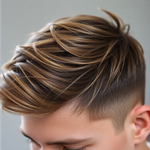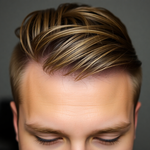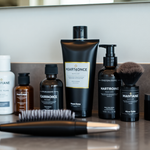Semi-Permanent Hair Color for Men: Match Shades to a Sustainable Capsule Wardrobe
15 August 2025
Share
Intro — A simple switch that elevates everything
Struggling to look sharp without breaking the bank? Semi-permanent hair color for men is an easy, low-commitment way to boost your look and tie your head-to-toe aesthetic into a sustainable capsule wardrobe. In just one session you can freshen greys, deepen your natural tone, or add a subtle accent that makes outfits pop—without heavy maintenance or long-term damage.
Semi-Permanent Hair Color for Men: Shade Selection and Wardrobe Match
Think of your hair as a finishing accessory. Your capsule wardrobe probably runs on a tight palette—navies, greys, olives, tans, blacks—so your hair should support that system. Choosing a semi-permanent shade that complements your clothes keeps your overall look cohesive and intentional.
Why semi-permanent is smart for the capsule wardrobe guy
- Low commitment: Fades over weeks to months, so you can experiment without long-term commitment.
- Less damage: These formulas typically sit on the hair surface rather than drastically altering the cortex, reducing breakage and the need for aggressive repair.
- Lower maintenance = greener footprint: Fewer salon returns and reduced use of strong chemicals means less environmental impact over time.
- Cost effective: At-home touch-ups and extended time between professional color appointments save money—key for building a sustainable wardrobe on a budget.
How the chemistry works (plain talk)
Semi-permanent dyes usually use smaller pigment molecules that coat the hair shaft. They don’t require strong developers or ammonia like permanent dyes. That’s why fades are gradual and the hair feels healthier afterward. For basic safety and scalp considerations, consult an authoritative resource such as WebMD’s hair color guide (WebMD).
Start with your wardrobe palette: a four-step system
- Audit your closet: Pull out the pieces you reach for most. Note the dominant hues (three to five colors).
- Decide contrast level: Do you like strong contrasts (dark hair, light clothes) or smoother transitions (low-contrast monochrome)?
- Pick a temperature: Warm wardrobes (earth tones) pair best with warm hair shades. Cool wardrobes (navy, charcoal) suit ash tones or cooler browns.
- Run a test: Use a strand test or temporary root touch-up product for one week to see how the shade sits against your clothes and skin.
Shade guide by wardrobe archetype
- The Minimalist: If your wardrobe runs monochrome or neutral, choose deep espresso, soft black, or an ash brown—clean, low-key, and easy to maintain.
- The Earthy Guy: Olive, tan, and brown-based outfits call for warm chestnut, caramel lowlights, or subtle copper tones to harmonize the palette.
- The Modern Professional: For navy and charcoal suiting, aim for cool browns or soft black; they read polished in meetings and photograph well for headshots.
- The Creative/Streetwear Fan: Muted color accents—smoked silver, bronze, or deep teal—work as controlled statements if your outfits contain complementing pops of color.
Matching to skin tone and undertone
Skin tone matters. Use this quick guide:
- Warm undertones: Golden or olive skin—warm browns, caramel, and copper feel natural.
- Cool undertones: Pinkish or blue-leaning skin—ash browns, cool blacks, and smoky blondes avoid clashing.
- Neutral undertones: You’re flexible—pick warm or cool shades based on the wardrobe you want to emphasize.
If you’re unsure of your undertone, check the veins test (blue means cool, green means warm) or how you look in silver vs. gold jewelry.
Salon vs. At-home: pros, cons, and when to choose which
- Salon: Pros: professional color matching, longer-lasting blends (e.g., balayage), and safer lifts. Cons: higher cost and more time.
- At-home: Pros: budget-friendly, flexible timing, and immediate control. Cons: risk of uneven application and color surprises if you skip a strand test.
For grey blending or complex multi-tone looks, a salon consult is worth the cost. For simple root refreshes, many men get excellent results at home with semi-permanent kits—just follow the directions and do a patch test.
Step-by-step at-home application (practical guide)
- Read instructions and do a 48-hour patch test for allergies.
- Prepare your workspace with towels and gloves; wear an old shirt.
- Apply to dry or slightly damp hair as directed—work product from roots to ends for coverage or ends up for refresh-only applications.
- Set a timer and rinse with cool water until the water runs clear; finish with a color-safe conditioner.
- Style as usual and evaluate after 24 hours in natural light before adjusting tone further.
Maintenance schedule that respects hair health
- Wash with sulfate-free, color-safe shampoo; cool water helps reduce fade.
- Use a color-depositing conditioner or a tinted leave-in product to refresh tone between applications.
- Deep-condition weekly if hair was previously bleached or feels dry.
- Reapply semi-permanent color every 4–12 weeks depending on how fast it fades and the result you want.
Styling and grooming: cut, texture, and facial hair
The same haircut reads differently depending on color. Here are pairing ideas:
- Textured crop + warm brown: Casual and modern; works with relaxed, layered capsule pieces.
- Taper fade + cool black: Sharp and professional—the safer option for conservative dress codes.
- Longer top + muted silver accent: Edgy without going full scene; pair with monochrome or all-black streetwear.
Match facial hair color subtly. If you have a beard, blending with semi-permanent tint or selective use of a beard-specific color product keeps the look cohesive.
Seasonal shifts and how to plan them
Use seasonality to guide small changes: spring/summer favors lighter, sun-kissed tones (caramel, warm blondes); fall/winter is great for richer, darker tones (chestnut, espresso) that pair with heavier layers. Semi-permanent options let you pivot without overcommitting.
Practical sustainability checklist
- Choose ammonia-free and low-peroxide options when possible.
- Look for brands with recyclable packaging or refill programs.
- Stretch salon visits; use targeted at-home top-ups instead of full professional services every time.
- Opt for cruelty-free and ethically sourced ingredient labels if those values matter to you.
Real-life mini-case studies
Case 1: Mike, 28, starts a capsule wardrobe for a new job. He chose a cool brown semi-permanent shade to pair with navy suits and grey knitwear. Result: fewer touch-ups, professional look, and improved confidence in meetings.
Case 2: Jamal, 36, blends early greys with a soft chestnut tint that complements his earth-toned casuals (olive jackets, tan boots). The color faded gracefully over two months, so he reapplied only twice a year and reduced salon trips.
Recommended product picks (including Menll.com)
For color-safe maintenance, look for sulfate-free shampoos and conditioners, plus a color-depositing conditioner for quick refreshes. Menll.com’s sustainable grooming line offers color-safe shampoos and the EcoTone Semi-Permanent Hair Tint, which is designed for low-commitment refreshes and comes in neutral and warm tones. Browse Menll.com’s grooming collection for matching aftercare: Menll.com sustainable grooming. Also consider pairing with Menll.coms capsule wardrobe guides to align outfit palettes: How to Build a Capsule Wardrobe.
Image and accessibility suggestions
Use clear visuals that show before/after, a top-down view of a capsule wardrobe, and swatch charts. Example captions and alt text to boost SEO:
- Caption: "Subtle chestnut tint pairs perfectly with earth-toned capsule pieces." Alt: "Man with chestnut semi-permanent hair color wearing olive jacket and tan shirt."
- Caption: "Cool ash brown for a modern professional look." Alt: "Close-up of man with ash brown hair and navy blazer."
FAQs — fast answers
- Q: Will semi-permanent color cover grey? A: It can blend and soften grey, especially when the grey is not the majority of hair. For full coverage, consult a stylist about demi-permanent or professional techniques.
- Q: How long does it last? A: Expect 4–12 weeks depending on product, hair porosity, and washing frequency.
- Q: Is it safe for sensitive scalps? A: Always do a patch test. If you have a history of reactions, check with a dermatologist before using dye.
Final notes on safety and credibility
Semi-permanent hair color for men is an accessible route to a more intentional, cohesive personal style. For verified safety information and possible allergic reactions, use trusted medical resources like WebMD: WebMD hair color safety. When in doubt, book a consultation with a professional colorist who can recommend formulas and an application approach suited to your goals and hair history.
Suggested meta (for publishing)
Meta title (50-60 chars): "Semi-Permanent Hair Color for Men — Capsule Wardrobe Match"
Meta description (150-160 chars): "Learn how semi-permanent hair color for men can boost a sustainable capsule wardrobe. Shade guides, maintenance tips, and product picks from Menll.com."
Wrap-up — small change, big cohesion
Integrating semi-permanent hair color into a sustainable capsule wardrobe is about intentional choices: shade, maintenance, and product selection. Keep it low-maintenance, choose eco-conscious products, and match tone to your clothes and skin for the sharpest payoff.
Engage — your turn
Which shade are you tempted to try with your capsule wardrobe? Drop a comment below or browse Menll.com for color-safe grooming essentials and wardrobe pieces that make coordination easy.
Vorheriger Beitrag

Palette Playbook: Matching Semi-Permanent Hair Color Tones to Your Sustainable Men's Wardrobe
Aktualisiert am 16 August 2025
Nächster Beitrag
Semi-Permanent Hair Color for Men: Subtle Shades That Elevate Your Sustainable Wardrobe
Aktualisiert am 14 August 2025





